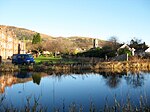Auchentoshan distillery

Auchentoshan distillery ( OKH-ən-TOSH-ən) is a single malt whisky distillery in the west of Scotland.: 15 The name Auchentoshan is from Gaelic Achadh an Oisein (Scottish Gaelic pronunciation: [ˈaxəɣ ən̪ ˈɔʃɛɲ]) and translates as "corner of the field". The distillery is also known as "Glasgow's Malt Whisky" due to its proximity to Glasgow and "the breakfast whisky" due to its sweet and delicate nature. Auchentoshan is located at the foot of the Old Kilpatrick Hills on the outskirts of Clydebank in West Dunbartonshire near the Erskine Bridge. It is one of six malt whisky distilleries in the Scottish Lowlands along with Lochlea Distillery, Glenkinchie and recently Daftmill Distillery, Annandale Distillery and Ailsa Bay Distillery.
Excerpt from the Wikipedia article Auchentoshan distillery (License: CC BY-SA 3.0, Authors, Images).Auchentoshan distillery
Great Western Road,
Geographical coordinates (GPS) Address Phone number Website External links Nearby Places Show on map
Geographical coordinates (GPS)
| Latitude | Longitude |
|---|---|
| N 55.922 ° | E -4.439 ° |
Address
Auchentoshan Distillery
Great Western Road
G81 4SJ , Dalmuir
Scotland, United Kingdom
Open on Google Maps









